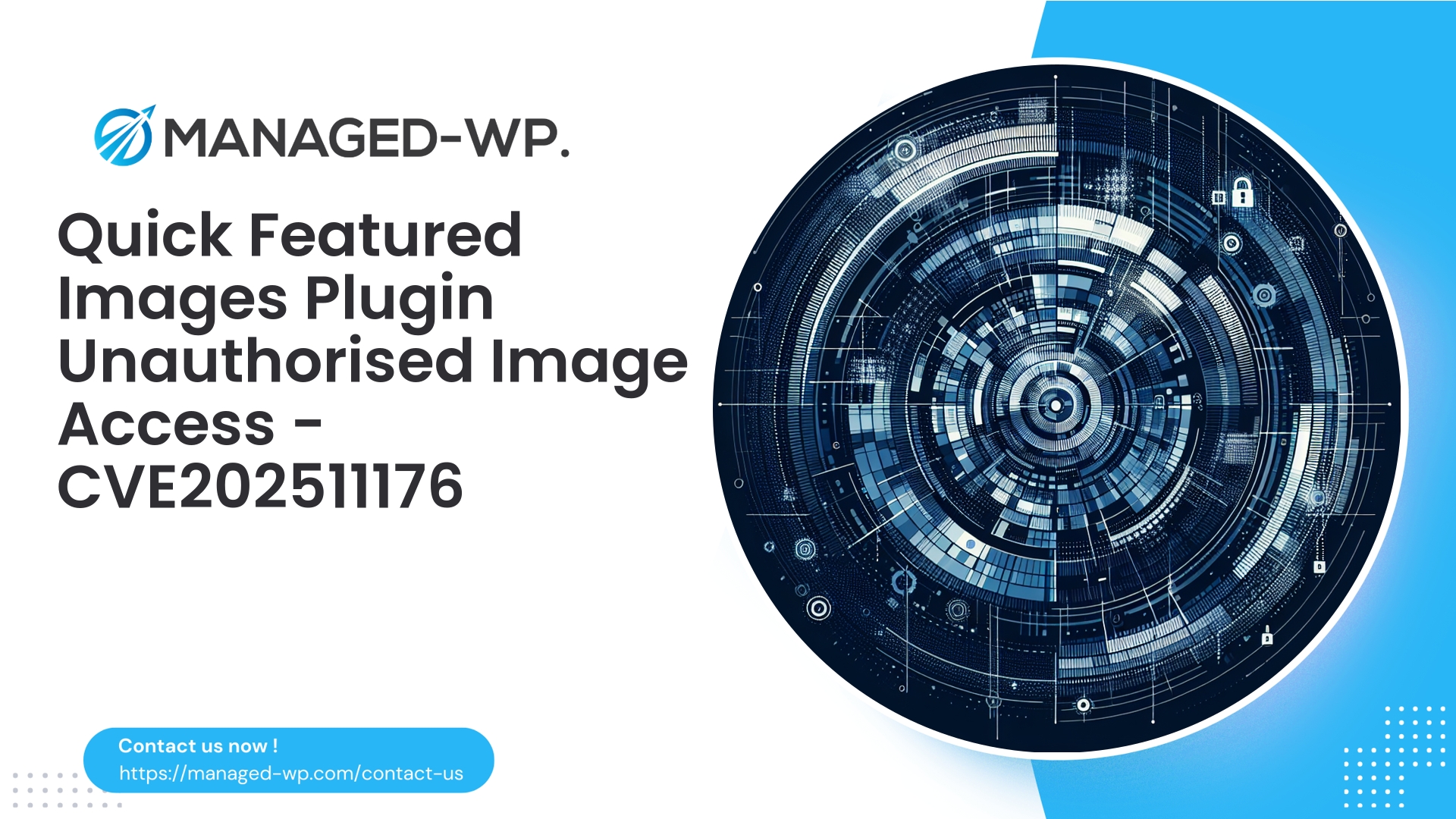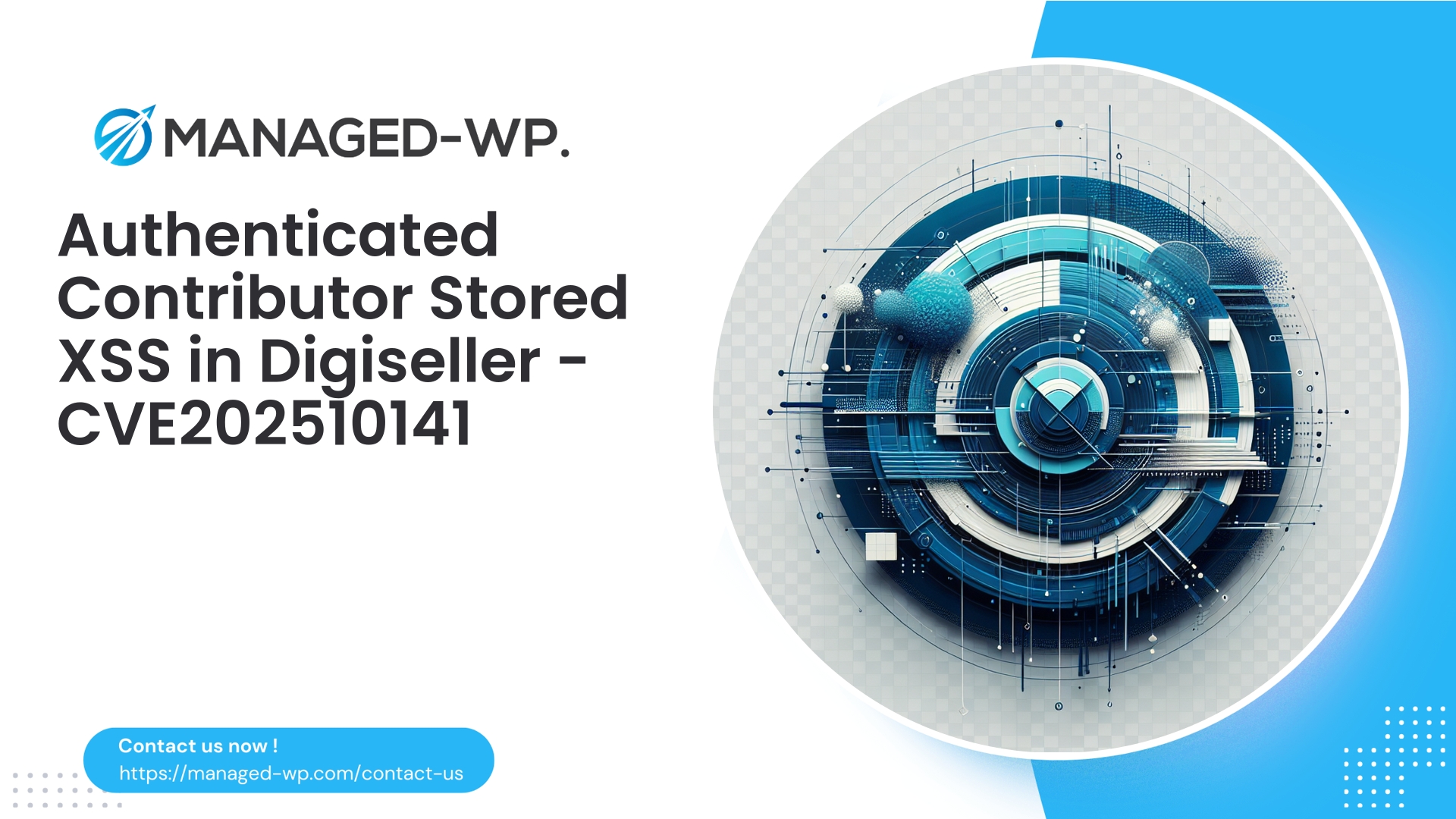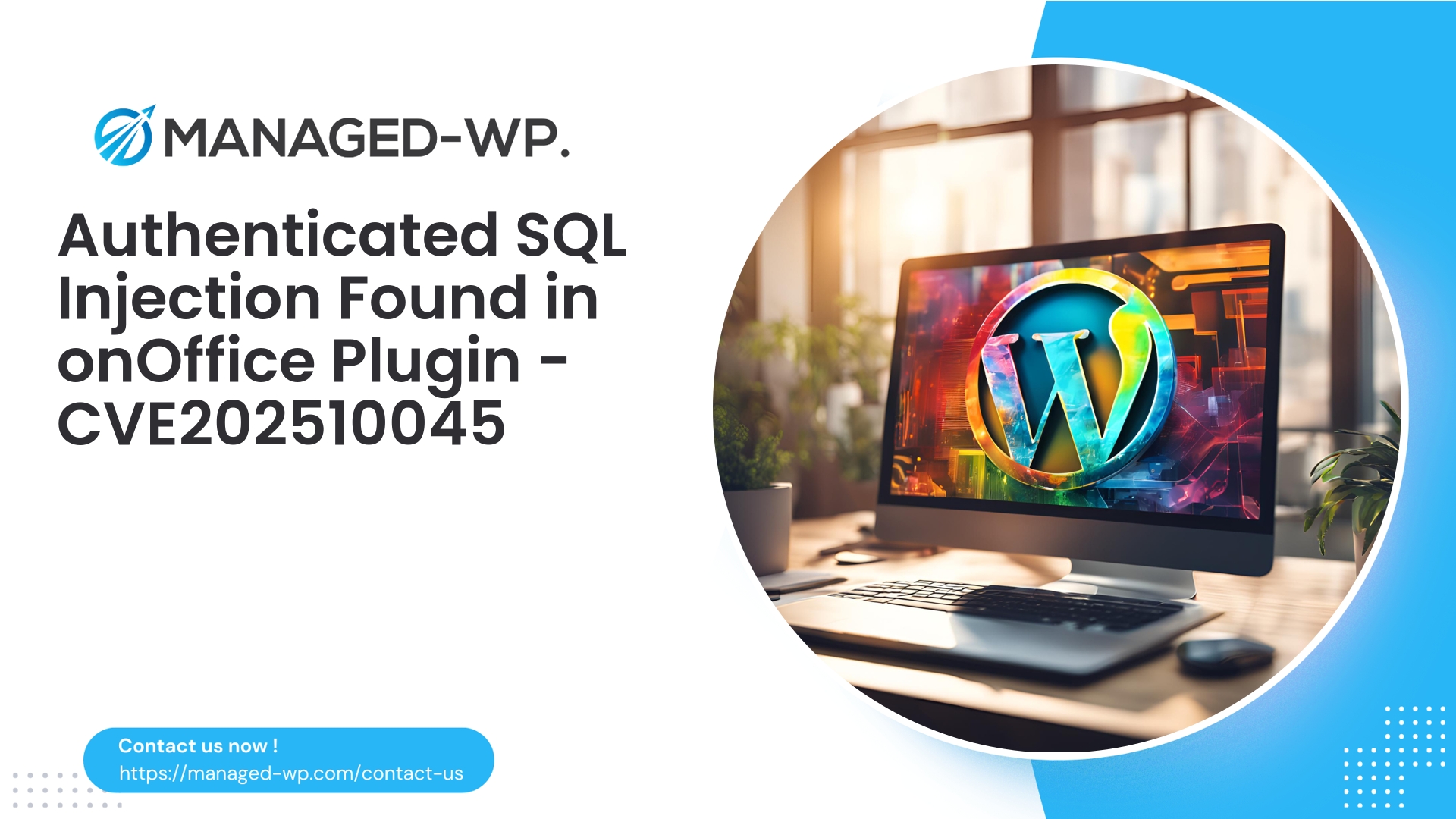| 插件名稱 | 快速特色圖片 |
|---|---|
| 漏洞類型 | 不安全直接物件參考 (IDOR) |
| CVE編號 | CVE-2025-11176 |
| 緊急 | 低的 |
| CVE 發布日期 | 2025-10-15 |
| 來源網址 | CVE-2025-11176 |
快速特色影像 (≤ 13.7.2) IDOR 漏洞利用導致影像竄改 — 使用 Managed-WP 進行風險分析、偵測和即時防護
作者:Managed-WP 安全團隊
摘要:快速特色圖片外掛程式中發現的不安全直接物件參考 (IDOR) 漏洞 (CVE-2025-11176) 允許具有作者等級權限的已認證使用者在其授權範圍之外操作影像物件。本簡報詳細介紹了漏洞的技術分析、潛在攻擊影響、檢測方法、緊急修復步驟,以及 Managed-WP 如何提供快速保護——包括如何輕鬆啟動免費套餐以立即保護您的 WordPress 實例。
目錄
- 背景和 CVE 概述
- 重要性:切實存在的風險與攻擊場景
- IDOR漏洞的技術分析
- 偵測技巧和入侵指標
- 關鍵補救措施
- 長期安全措施和場地加固
- 虛擬補丁和WAF規則範例
- 事件回應和復原指南
- 插件治理與最小權限最佳實踐
- 立即保護您的網站—啟動您的免費託管 WordPress 安全計劃
- 附錄:範例檢測命令和 PHP 安全加固程式碼片段
背景和 CVE 概述
Quick Featured Images 外掛程式 13.7.2 及更早版本有 IDOR 漏洞,漏洞編號為 CVE-2025-11176。此漏洞會破壞影像處理函數中的授權檢查。供應商已在 13.7.3 版本中修復了此問題。
關鍵細節:
- 漏洞類型:不安全的直接物件參考 (IDOR)
- CVE編號:CVE-2025-11176
- 受影響版本:13.7.2 及以下版本
- 已在版本 13.7.3 中修復
- 利用此漏洞需要:已認證且具有作者級別權限的用戶
- CVSS評分:4.3(低)-受所需權限限制,但在多作者或會員環境中仍適用
此漏洞使已認證的作者能夠繞過適當的所有權檢查並操縱他們不擁有的圖像附件,從而構成具體的威脅,具體取決於您網站的用戶管理和內容策略。
重要性:切實存在的風險與攻擊場景
乍看之下,對媒體物件進行 IDOR 似乎影響甚微。然而,實際應用中的濫用可能會產生重大影響,包括:
- 未經授權的內容變更: 作者可能會互換他人貼文中的特色圖片,誤導訪客或造成內容竄改。
- 惡意內容傳播: 攻擊者可能會將媒體引用重新分配給惡意負載,從而促進網路釣魚或惡意軟體的傳播。
- 品牌和搜尋引擎優化損害: 用冒犯性或垃圾內容取代合法圖片會降低信任度,導致搜尋引擎懲罰或內容刪除。
- 憑證升級風險: 雖然直接的權限提昇在這裡並不常見,但攻擊者可以將其與弱憑證或易受攻擊的插件結合起來,從而加劇影響。
- 透過供應鏈擴大風險敞口: 在電子郵件、新聞簡報或其他地方嵌入的篡改圖像可能會將風險擴散到受影響的 WordPress 網站之外。
鑑於許多 WordPress 安裝都允許作者或編輯貢獻者進行編輯,這種攻擊途徑切實可行,需要立即予以重視。
IDOR漏洞的技術分析
當應用程式使用物件參考而沒有進行健全的所有權或權限驗證時,就會出現 IDOR 漏洞。
在此背景下:
- 該插件公開了接受附件 ID 的 admin-ajax 或 REST 端點。
- 操作包括設定特色圖片、替換、刪除或更改元資料。
- 程式碼驗證使用者身份驗證並粗略檢查權限,但未能確認附件是否屬於請求使用者。
- 結果是,授權被繞過,使得作者能夠修改他們不應該控制的媒體資源。
利用場景範例:
- 作者帳戶的外洩或合法持有。
- 提交精心建構的 POST 請求,引用他人擁有的附件 ID。
- 該插件在未進行所有權驗證的情況下處理這些請求,執行未經授權的媒體操作。
- 攻擊者的修改會公開顯示或影響網站內部內容。
筆記: 確切的參數名稱和端點 URL 可能有所不同,但核心問題是附件操作缺少所有權檢查。
偵測技巧和入侵指標
請警惕以下可能表明此漏洞已被利用的跡象:
- 意外的 POST 請求
/wp-admin/admin-ajax.php參數如下操作=[plugin_action]加attachment_id或類似說法。 - 附件元資料時間戳更改,其中作者與通常的所有權不同。
- 新上傳或修改的文件
/wp-content/uploads名稱不規範或內容類型可疑。 - 文章特色圖片在文章內容未相應更改的情況下發生更改。
- 由具有作者角色的使用者執行的大批量圖像操作。
- 惡意軟體掃描發出警報,提示媒體檔案異常。
- 異常流量模式針對來自非典型來源的媒體資源。
檢測方法:
- 檢查 Web 伺服器日誌中是否有可疑的 admin-ajax POST 請求。
- 使用 WP-CLI 審核最近的附件和所有權資訊。
- 掃描上傳目錄,尋找意外的檔案類型和嵌入的惡意負載。
- 監控資料庫中插件相關的元資料變更。
- 在尊重隱私和合規性的前提下,盡可能對 AJAX 和 REST 呼叫使用進階日誌記錄(偵錯等級)。
關鍵補救措施
如果您的網站運行的是 Quick Featured Images 13.7.2 或更低版本,請立即採取以下優先步驟:
- 更新外掛: 升級到 13.7.3 或更高版本——這將徹底修復漏洞。
- 更新延遲時的暫時緩解措施:
- 暫時停用該插件,直到套用補丁為止。
- 使用 Managed-WP 或自訂防火牆規則實現虛擬修補(請參閱下一節)。
- 審核使用者權限:
- 禁用作者角色的公開註冊。
- 檢視並清理現有作者帳戶,以識別可疑或不活躍的使用者。
- 強制更新憑證: 輪換密碼,並為特權使用者啟用雙重認證。
- 檢查媒體檔案和資料庫: 尋找可疑變更或未經授權的上傳。
- 通知您的安全團隊並準備事件回應工作流程。
雖然該漏洞需要 Author 帳戶才能生效,但低權限洩漏往往是更嚴重洩漏的前兆,因此迅速採取行動至關重要。
長期安全措施和場地加固
實施以下策略,以減少類似授權漏洞帶來的風險,並提升整體安全態勢:
- 運用最小特權原則: 限制使用者權限,僅授予必要的權限。盡可能移除不必要的「上傳檔案」或「編輯文章」權限。
- 強制執行嚴格的隨機數和能力檢查: 插件開發者應嚴格驗證 nonce 值並確認每個目標物件的所有權。
- 驗證上傳的文件: 使用諸如此類的工具強制執行 MIME 類型檢查並驗證影像完整性
取得影像大小()或 Imagick。 - 限制公開註冊: 要求管理員批准或停用有權更改內容的角色的公開註冊。
- 保持 WordPress 核心、主題和外掛的更新;及時刪除未使用或不受支援的外掛程式。
- 集中式日誌記錄與監控: 啟用 AJAX 和 REST 活動的詳細日誌;配置批次或異常檔案操作的警報。
- 維護可靠的離線備份: 保留不可篡改的副本,以便在資料外洩時能夠恢復。
虛擬補丁和WAF規則範例
雖然升級仍然是最佳選擇,但虛擬修補程式可以提供快速有效的臨時保護——尤其適用於具有複雜發布週期的眾多網站。 Managed-WP 提供可擴展的虛擬補丁,可立即保護易受攻擊的端點。
以下是一些概念範例,可引導您制定自己的規則或實作 Managed-WP 控制項(部署前請進行充分測試):
策略 A — 阻止缺少有效 nonce 的 admin-ajax 請求
SecRule REQUEST_URI "@pm /wp-admin/admin-ajax.php" "phase:2,chain,deny,status:403,log,msg:'阻止沒有 nonce 的 QFI AJAX 請求'" SecRule ARGS:action "@contains qfi" Secak:2, GS」
此規則禁止在沒有必需的 WordPress nonce 的情況下透過 AJAX 呼叫圖片操作。
策略 B — 偵測並限制大量影像操作
- 限制每 IP 每分鐘對影像操作的 admin-ajax POST 請求數不得超過 10 個。
- 同一用戶對多個附件 ID 進行快速變更時發出警報。
策略 C — 限制非管理員使用者對 REST 端點的訪問
- 阻止或質疑插件 REST 路由上的 POST/PUT/DELETE 方法(
/wp-json/qfi/v1/*)來自沒有管理員角色的使用者。
策略 D — 託管工作包虛擬修補程式實施
Managed-WP 解決方案可以部署一個 mu 插件,該插件可以:
- 攔截插件的 AJAX 和 REST 呼叫。
- 驗證 nonce 值。
- 檢查目前使用者是否擁有正在修改的附件。
- 在外掛程式碼運行之前,如果存取未經授權,則傳回 HTTP 403 錯誤。
範例 PHP 程式碼片段:
<?php
// Mu-plugin placed to enforce attachment ownership and nonce validation
add_action('admin_init', function() {
if ( ! is_admin() ) return;
if ( empty($_POST['action']) || strpos($_POST['action'], 'qfi_') !== 0 ) return;
if ( $_POST['action'] === 'qfi_set_image' ) {
if ( empty($_POST['_ajax_nonce']) || ! wp_verify_nonce($_POST['_ajax_nonce'], 'qfi_nonce_action') ) {
wp_die('Invalid nonce', '', 403);
}
$attachment_id = intval($_POST['attachment_id'] ?? 0);
if ( $attachment_id ) {
$owner_id = (int) get_post_field('post_author', $attachment_id);
$current = get_current_user_id();
if ( ! current_user_can('manage_options') && $owner_id !== $current ) {
wp_die('Not authorized to change this attachment', '', 403);
}
}
}
}, 1);
這段程式碼片段僅供參考;Managed-WP 可立即在多個用戶端上套用經過測試的生產級等效程式碼。
事件回應和復原指南
懷疑有剝削行為,需要迅速、有組織地應對:
- 保留證據: 匯出涵蓋事件視窗的日誌和資料庫快照。
- 遏止違規行為: 將網站置於維護模式或封鎖可疑流量。
- 立即更新或停用存在漏洞的插件。
- 輪換所有敏感憑證,並使所有作者及以上級別的會話失效。
- 掃描上傳檔案是否有惡意程式或惡意檔案;刪除已識別的威脅。
- 如果確認有修改,請從乾淨的備份中還原媒體。
- 審核並核對內容完整性,修復已更改的貼文或元資料。
- 通知相關利益方,並根據適用情況履行法律規定的違規報告義務。
- 進行根本原因分析,以防止未來發生帳戶盜用事件。
- 實施事故後加固措施。
插件治理與最小權限最佳實踐
降低外掛程式和用戶相關風險,首先要加強營運控制:
- 安裝插件前務必仔細審查: 審查更新頻率、社群回饋和安全歷史記錄。
- 盡量減少提升權限: 當插件需要高權限時,應評估風險;盡量減少存取權限。
- 及時更新政策: 盡快測試並推出安全補丁,最好透過 CI/CD 和預發布環境進行。
- 實施角色限制: 使用管理外掛程式來控制誰可以成為作者或編輯,並嚴格限制上傳權限。
- 監控插件特定活動: 追蹤 AJAX、REST 和上傳事件的異常。
- 針對多站點環境的集中管理: 統一協調更新和補丁。
立即保護您的網站—啟動您的免費託管 WordPress 安全計劃
我們深知 WordPress 的安全防護可能十分複雜。 Managed-WP 提供免費的基礎版服務,包含必要的防火牆和惡意軟體掃描功能,在您更新或加固網站的同時,為您提供即時保護。
為什麼選擇 Managed-WP Basic(免費版)?
- 託管式、專注於 WordPress 的防火牆和 WAF。
- 無限頻寬,無需額外費用
- 惡意軟體掃描可識別可疑的上傳內容和媒體竄改。
- 針對 WordPress 客製化的 OWASP 主要風險緩解措施
- 快速激活,立即覆蓋您的網站
升級選項包括自動清除惡意軟體、IP 黑名單/白名單控制、虛擬修補程式自動化、每月安全報告和進階附加元件。
從這裡開始: https://my.wp-firewall.com/buy/wp-firewall-free-plan/
如果您需要專家協助,我們的 Managed-WP 安全工程師隨時準備協助您分析風險、準備應對措施並大規模部署虛擬修補程式。
附錄:範例檢測命令和 PHP 安全加固程式碼片段
以下是一些實用範例,您的團隊可以在生產部署之前在開發環境中仔細調整和測試。
a) 管理員 AJAX 請求搜尋(grep 範例)
grep "admin-ajax.php" /var/log/nginx/access.log | grep -E "attachment_id|image_id|action=.*(qfi|featured|image)" | less
b) 使用 WP-CLI 列出最近的媒體更改
wp post list --post_type=attachment --fields=ID,post_title,post_author,post_modified --orderby=post_modified --order=DESC --format=table
識別具有不同作者元資料的附件:
wp db query "SELECT ID, post_title, post_author, post_modified FROM wp_posts WHERE post_type='attachment' ORDER BY post_modified DESC LIMIT 100;"
c) 用於緩解濫用的概念性 ModSecurity 規則
SecRule REQUEST_URI "@contains /wp-admin/admin-ajax.php" "phase:2,pass,nolog,chain" SecRule ARGS:action "@pm qfi_set_image qfi_update_image qfi_replace_image" "chain_set_image qfi_update_image qfi_replace_image" "chain_set_image qfi_update_image qfi_replace_image" "chain,phase:2,9deny,phasestat:47,400,005,000,005,005,005,0055,505,0055,505,000 圖像率」, 45,000,0005,000,005,005,005,005,005率 圖像」?
將操作名稱調整為與插件鉤子完全匹配的名稱。速率限制可以減少自動化濫用行為的數量。
d) 用於虛擬修補的 Mu 插件 PHP 程式碼片段
<?php
/*
Plugin Name: Virtual Patch - QFI Attachment Ownership Enforcement
Description: Enforce nonce verification and ownership checks on QFI image manipulation actions.
Version: 1.0
Author: Managed-WP Security Team
*/
add_action('admin_init', function() {
if ( ! is_admin() || empty($_REQUEST['action']) ) return;
$action = sanitize_text_field($_REQUEST['action']);
// Replace with Verified Quick Featured Images actions
$protected_actions = ['qfi_set_featured', 'qfi_replace_attachment'];
if ( in_array($action, $protected_actions, true) ) {
if ( empty($_REQUEST['_ajax_nonce']) || ! wp_verify_nonce(sanitize_text_field($_REQUEST['_ajax_nonce']), 'qfi_nonce') ) {
status_header(403); wp_die('Forbidden: nonce verification failed', '', 403);
}
$attachment_id = intval($_REQUEST['attachment_id'] ?? 0);
if ( $attachment_id > 0 ) {
$owner = (int) get_post_field('post_author', $attachment_id);
$current = get_current_user_id();
if ( ! current_user_can('manage_options') && $owner !== $current ) {
status_header(403); wp_die('Forbidden: insufficient permissions to modify this attachment', '', 403);
}
}
}
}, 0);
在官方外掛程式更新發布之前,此 mu 外掛程式可作為有效的臨時安全措施。
最後想說的
WordPress 的安全防護建立在縱深防禦之上。雖然由於所需權限較低,此「快速特色圖片」漏洞的 CVSS 評分較低,但在多作者、會員製或開放貢獻環境中,其影響會被放大。因此,透過插件更新、虛擬補丁和事件監控進行即時修復至關重要。
Managed-WP 使網站所有者和安全團隊能夠快速回應並維護多層防禦:
- 即時虛擬補丁阻止未經授權的媒體修改
- 持續的WAF保護和進階惡意軟體掃描
- 可擴展的解決方案,以保持編輯工作流程的完整性
像保護後端一樣保護您的媒體資產。立即使用 Managed-WP 的免費基礎套餐,在您進行修復的同時保護您的 WordPress 生態系統: https://my.wp-firewall.com/buy/wp-firewall-free-plan/
需要專家支援?請聯絡我們的 Managed-WP 安全工程師,以取得風險分析、虛擬修補程式部署以及跨單一或多個 WordPress 網站的全面事件回應協調服務。



















